Modeling of Transport of Loose Products with the Use of the Non-Grid Method of Discrete Elements (DEM)
Abstract
1. Introduction
2. Materials and Methods
2.1. DEM Model Used for the Calculations
2.2. Mathematical Model
- -
- Determination of forces acting on individual particles resulting from their mass;
- -
- Calculation of interactions with walls or other particles.
- Locates all adjacent particles and borders with which the particle will come into contact;
- Calculates the sum of all forces (Euler Equation);
- Acting on the particle:
3. Results
3.1. Forces Acting on a Particle
3.1.1. Normal Forces
3.1.2. Tangential Forces
- is the value of this force from the previous time step;
- Δsτ is mutual relative deformation;
- Kτ is the tangent stiffness defined as the fraction of normal stiffness from Equation (4).
3.2. Shock Conveyors—Motion Analysis
3.3. The Boundary Conditions Used in the Calculations
- There is no particles at the beginning of the simulation. The particles are injected to the domain at each time step of the simulation with constant mass flow of 0.1 kg/s, the same for both simulations.
- The particles are removed after leaving the domain.
- The particles are spherical. It is possible due to fruits shape and with implementation of rolling resistance. Additionally, it is possible to perform DEM simulation of any kind of shape.
- The Young modulus for particles was 0.61 MPa.
- coefficient of rolling resistance, defined as a tangent of maximal slope on which resistance moment counteracts the torque caused by the tangential forces [34];
- —rolling radius—vector joining particle center and the contact point;
- —contact normal force;
- —particle angular velocity.
- Vibrating movement, where the movement took place in the direction of 45 degrees of inclination to the conveyor plane (Figure 5) with a frequency of 15 Hz and amplitude of 3 mm;
- Reciprocating movement, where the movement took place in the feeder line (Figure 4) with a 6 mm pitch. The return movement of the gutter is faster than the forward movement and the time for each of them was 0.01 s and 0.03 s, respectively.
4. Discussion
5. Conclusions
Author Contributions
Funding
Conflicts of Interest
References
- Zhong, W.; Yu, A.; Liu, X.; Tong, Z.; Zhang, H. DEM/CFD-DEM modelling of non-spherical particulate systems: Theoretical developments and applications. Powder Technol. 2016, 302, 108–152. [Google Scholar] [CrossRef]
- Lu, G.; Third, J.; Chen, J. Discrete element models for non-spherical particle systems: From theoretical developments to applications. Chem. Eng. Sci. 2015, 127, 425–465. [Google Scholar] [CrossRef]
- Fonte, C.B.; Oliveira, J.A.J.; De Almeida, J.; Lucilla, C. DEM-CFD Coupling: Mathematical modelling and case studies using Rocky-DEM® and Ansys Fluent®. In Proceedings of the 11th International Conference on CFD in the Minerals and Process Industries, CSIRO, Melbourne, Australia, 7–9 December 2015; pp. 1–7. [Google Scholar]
- Holt, J.E.; Schoorl, D. Mechanics of failure in fruits and vegetables. J. Texture Stud. 1982, 13, 83–96. [Google Scholar] [CrossRef]
- Menesatti, P.; Paglia, G. PH—Postharvest technology: Development of a drop damage index of fruit resistance to damage. J. Agric. Eng. Res. 2001, 80, 53–64. [Google Scholar] [CrossRef]
- Höhne, T.; Rayya, A.; Montoya, G. Numerical modelling of horizontal oil-water pipe flow. Energies 2020, 13, 5042. [Google Scholar] [CrossRef]
- Tang, W.; Roman, D.; Dickie, R.; Robu, V.; Flynn, D. Prognostics and health management for the optimization of marine hybrid energy systems. Energies 2020, 13, 4676. [Google Scholar] [CrossRef]
- Viccione, G.; Stoppiello, M.G.; Lauria, S.; Cascini, L. Numerical modeling on fate and transport of pollutants in the vadose zone. Environ. Sci. Proc. 2020, 2, 34. [Google Scholar] [CrossRef]
- Manenti, S.; Wang, D.; Domínguez, J.M.; Li, S.; Amicarelli, A.; Albano, R. SPH modeling of water-related natural hazards. Water 2019, 11, 1875. [Google Scholar] [CrossRef]
- Gibaud, R. Application of the Discrete Element Method to Finite Inelastic Strain in Multi-Materials. Ph.D. Thesis, Université Grenoble Alpes, Saint-Martin-d’Hères, France, 2017. [Google Scholar]
- Kryszak, D.; Olejnik, T.P. Linear motion mechanisms in the transport of loose products in the food industry. Przemysł Spożywczy 2018, 12, 42. [Google Scholar] [CrossRef]
- Ayaz, F.A.; Kadioglu, A.; Bertift, E.; Acar, C.; Turna, I. Effect of fruit maturation on sugar and organic acid composition in two blueberries (Vaccinium arctostaphylos and V. myrtillus) native to Turkey. N. Z. J. Crop Hortic. Sci. 2010, 29, 137–141. [Google Scholar] [CrossRef]
- Freireich, B.; Litster, J.; Wassgren, C.R. Using the discrete element method to predict collision-scale behavior: A sensitivity analysis. Chem. Eng. Sci. 2009, 64, 3407–3416. [Google Scholar] [CrossRef]
- Kowal, K. Zagrożenia mikrobiologiczne produktów owocowych i warzywnych. Przemysł Spożywczy 2014, 6, 28–30. [Google Scholar]
- Li, L.; Pegg, R.B.; Eitenmiller, R.; Chun, J.; Kerrihard, A. Selected nutrient analyses of fresh, fresh-stored and frozen fruits and vegetables. J. Food Compos. Anal. 2017, 59, 8–17. [Google Scholar] [CrossRef]
- Tuzcu, E.T.; Rajamani, R.K. Modeling breakage rates in mills with impact energy spectra and ultra fast load cell data. Miner. Eng. 2011, 24, 252–260. [Google Scholar] [CrossRef]
- Kojima, T.; Liu, J.; Fujita, S.; Inaba, S.; Tanaka, M.; Tatara, I. Analysis of vibration and its effects on strawberries during highway transport. J. Soc. Agric. Struct. 1999, 29, 197–203. [Google Scholar]
- Nakamura, N.; Inatsu, Y.; Kawamoto, S.; Okadome, H.; Nakano, H.; Maezawa, S.; Shiina, T. Effect of vibration on the bacterial growth on strawberry fruits. J. Food Agric. Environ. 2014, 5, 44–48. [Google Scholar]
- Tartakovskya, A.M.; Ferrisa, K.F.; Meakin, P. Lagrangian particle model for multiphase flows. Comput. Phys. Commun. 2009, 180, 1874–1881. [Google Scholar] [CrossRef]
- Guo, Y.; Curtis, J.S. Discrete element method simulations for complex granular flows. Annu. Rev. Fluid Mech. 2015, 47, 21–46. [Google Scholar] [CrossRef]
- DEM Technical Manual. Available online: https://rocky.esss.co/technical-library/ (accessed on 20 December 2019).
- Walton, O.R.; Braun, R.L. Viscosity, granular-temperature, and stress calculations for shearing assemblies of inelastic, frictional disks. J. Rheol. 1986, 30, 949–980. [Google Scholar] [CrossRef]
- Almeida, E.; Spogis, N.; Silva, M.A. Computational study of the pneumatic separation of sugarcane bagasse. In Proceedings of the 6th International Conference on Engineering for Waste and Biomass Valorisation, Albi, France, 23–26 May 2016; pp. 1–16. [Google Scholar]
- ESSS-Rocky. Rocky-Dem Technical Manual; Engineering Simulation and Scientific Software: Rio de Janeiro, Brazil, 2018; pp. 4–6. [Google Scholar]
- Walton, O.R. Numerical simulation of inelastic, frictional particle interactions. In Two-Phase Flow, 2nd ed.; Roco, M.C., Ed.; Butterworth-Heinemann, a Division of Reed Publishing (USA) Inc.: Oxford, UK, 1993; pp. 855–947. [Google Scholar]
- Company Advertising Materials Mysak Group. Available online: http://www.przenosnikitransportowe.pl/produkt9.html (accessed on 20 September 2020).
- Goździecki, M.; Świątkiewicz, H. Przenośniki; WNT: Warsaw, Poland, 1979. [Google Scholar]
- Hua, M.H.; Dong, Q.L.; Liu, B.L.; Umezuruike, L.; Chen, O.L. Estimating blueberry mechanical properties based on random frog selected hyperspectral data. Postharvest Biol. Technol. 2015, 106, 1–10. [Google Scholar] [CrossRef]
- Heim, A.; Olejnik, T.P.; Pawlak, A. Using statistical moments to describe grinding in a ball mill for industrial-scale process. Chem. Eng. Process. 2005, 44, 263–266. [Google Scholar] [CrossRef]
- Olejnik, T.P. Milling kinetics of chosen rock materials under dry conditions considering strength and statistical properties of bed. Physicochem. Probl. Miner. Process. 2011, 46, 145–154. [Google Scholar]
- Olejnik, T.P. Analysis of the breakage rate function for selected process parameters in quartzite milling. Chem. Process Eng. 2012, 33, 117–129. [Google Scholar] [CrossRef]
- Olejnik, T.P. Kinetics of gringing ceramic bulk considering grinding media contact points. Physicochem. Probl. Miner. Process. 2010, 44, 187–194. [Google Scholar]
- Ławińska, K.; Modrzewski, R.; Serweta, W. The phenomenon of screen blocking for mixtures of varying blocking grain content. Gospod. Surowcami Miner. 2018, 34, 83–95. [Google Scholar]
- Ai, J.; Chen, J.F.; Rotter, J.M.; Ooi, J.Y. Assessment of rolling resistance models in discrete element simulations. Powder Technol. 2010, 206, 269–282. [Google Scholar] [CrossRef]
- Heim, A.; Solecki, M. Yeast disintegration in a classical bead mill equipped with stationary baffles. Chem. Process Eng. 2002, 23, 5–19. [Google Scholar]
- Lawinska, K.; Wodzinki, P.; Modrzewski, P. Verification of the mathematical model of the screen blocking process. Powder Technol. 2014, 256, 506–511. [Google Scholar] [CrossRef]
- Jewiarz, M.; Wróbel, M.; Mudryk, K.; Szufa, S. Impact of the drying temperature and grinding technique on biomass grindability. Energies 2020, 13, 3392. [Google Scholar] [CrossRef]
- Ławińska, K.; Szufa, S.; Obraniak, A.; Olejnik, T.; Siuda, R.; Kwiatek, J.; Ogrodowczyk, D. Disc granulation process of carbonation lime mud as a method of post-production waste management. Energies 2020, 13, 3419. [Google Scholar] [CrossRef]
- Wautier, A.; Bonelli, S.; Nicot, F. Scale separation between grain detachment and grain transport in granular media subjected to an internal flow. Granul. Matter 2017, 19, 22. [Google Scholar] [CrossRef]
- Zhang, S.; Cheng, X. Small-strain shear moduli modeling of sand: A non-equilibrium thermodynamic approach, including an application to Leighton Buzzard sand. Granul. Matter 2019, 21, 68. [Google Scholar] [CrossRef]
- Liu, L.; Bo, T. A study on the initiation of saltation in the model of wind-blown sand transport considering the effect of turbulence. Granul. Matter 2019, 21, 78. [Google Scholar] [CrossRef]
- Maeda, K.; Sakai, H.; Kondo, A.; Yamaguchi, T.; Fukuma, M.; Nukudani, E. Stress-chain based micromechanics of sand with grain shape effect. Granul. Matter 2010, 12, 499–505. [Google Scholar] [CrossRef]
- Cabrera, M.A.; Wu, W. Experimental modelling of free-surface dry granular flows under a centrifugal acceleration field. Granul. Matter 2017, 19, 78. [Google Scholar] [CrossRef]
- Gilberg, D.; Steiner, K. Size segregation in compressible granular shear flows of binary particle systems. Granul. Matter 2020, 22, 45. [Google Scholar] [CrossRef]
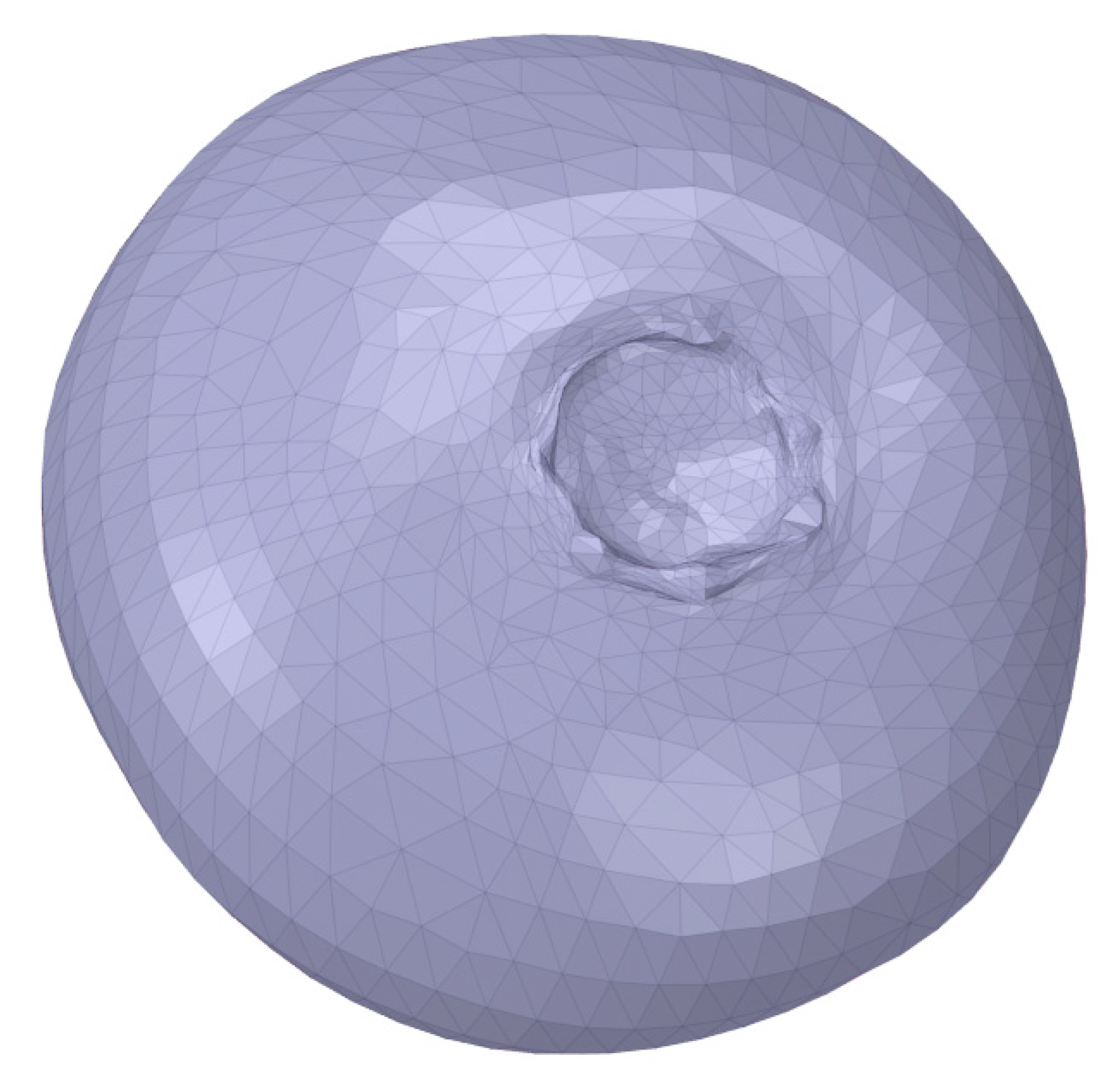

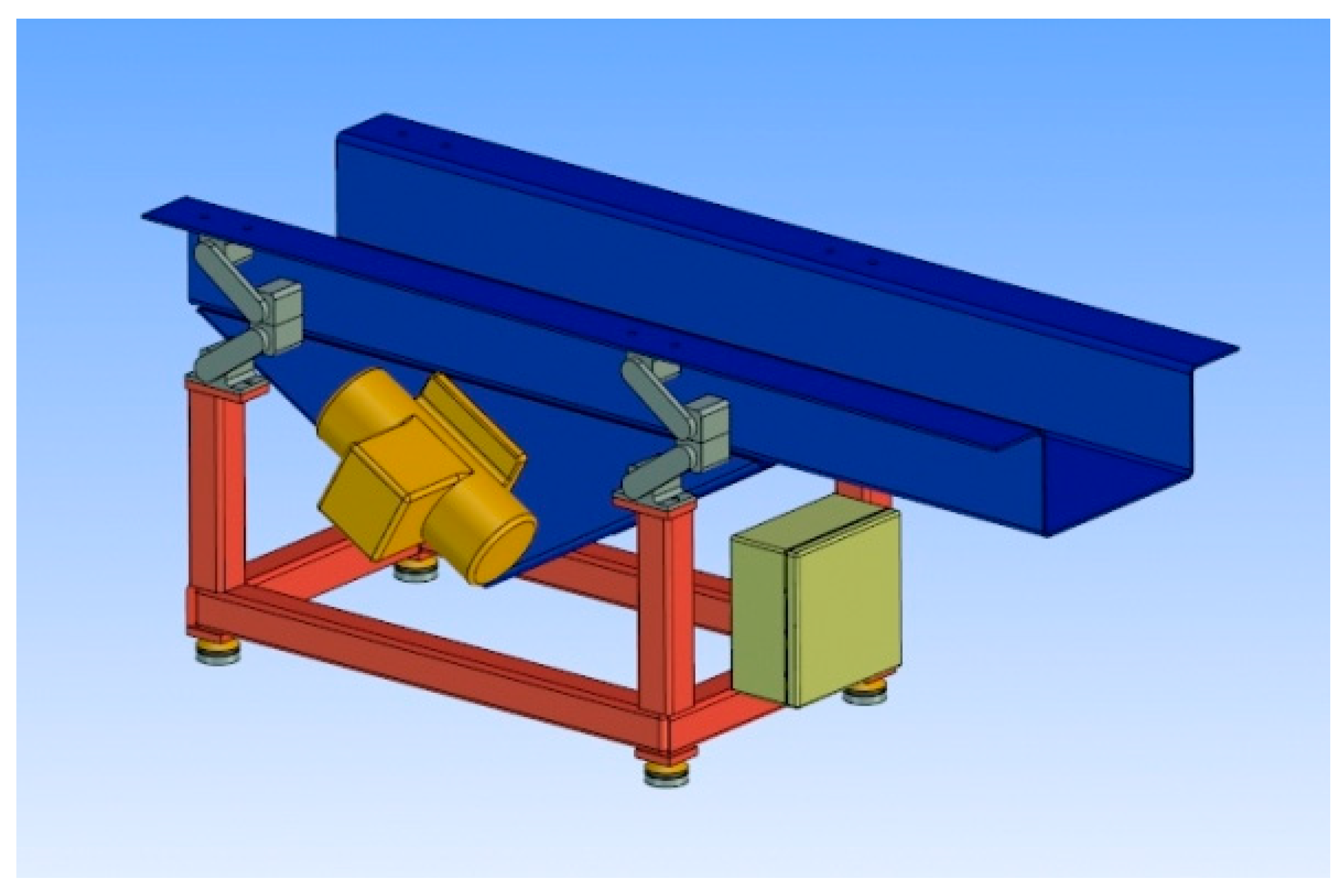


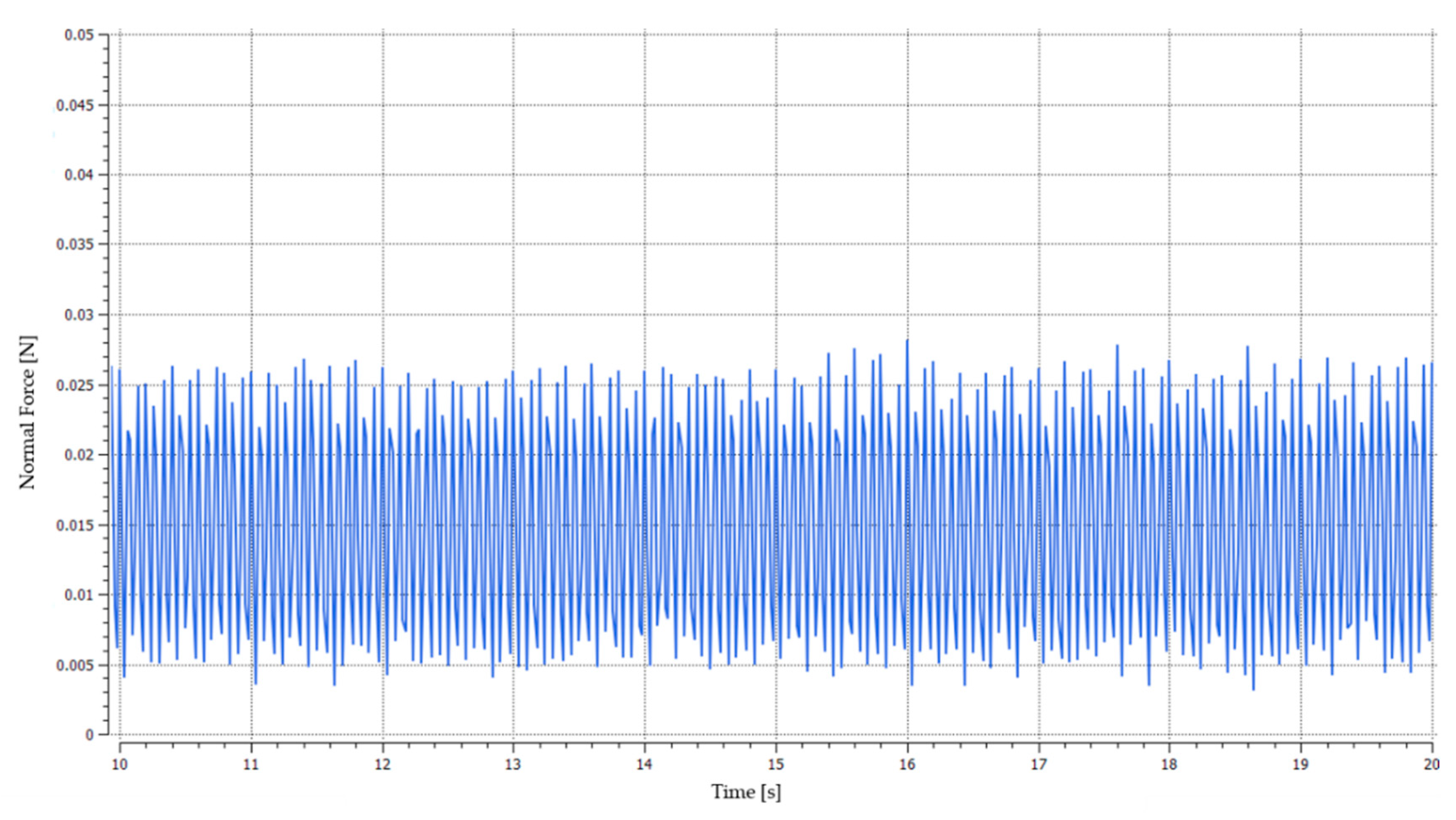
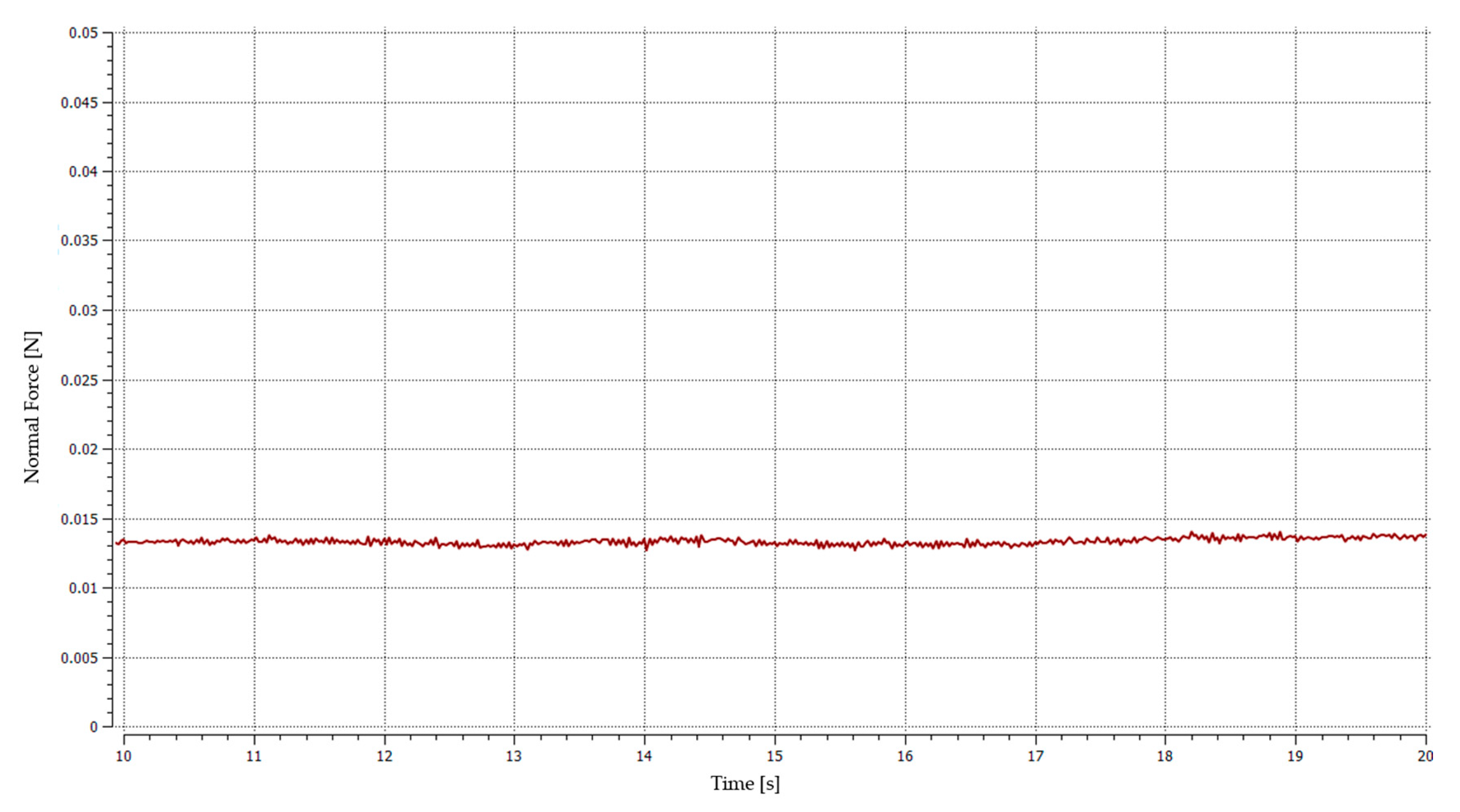
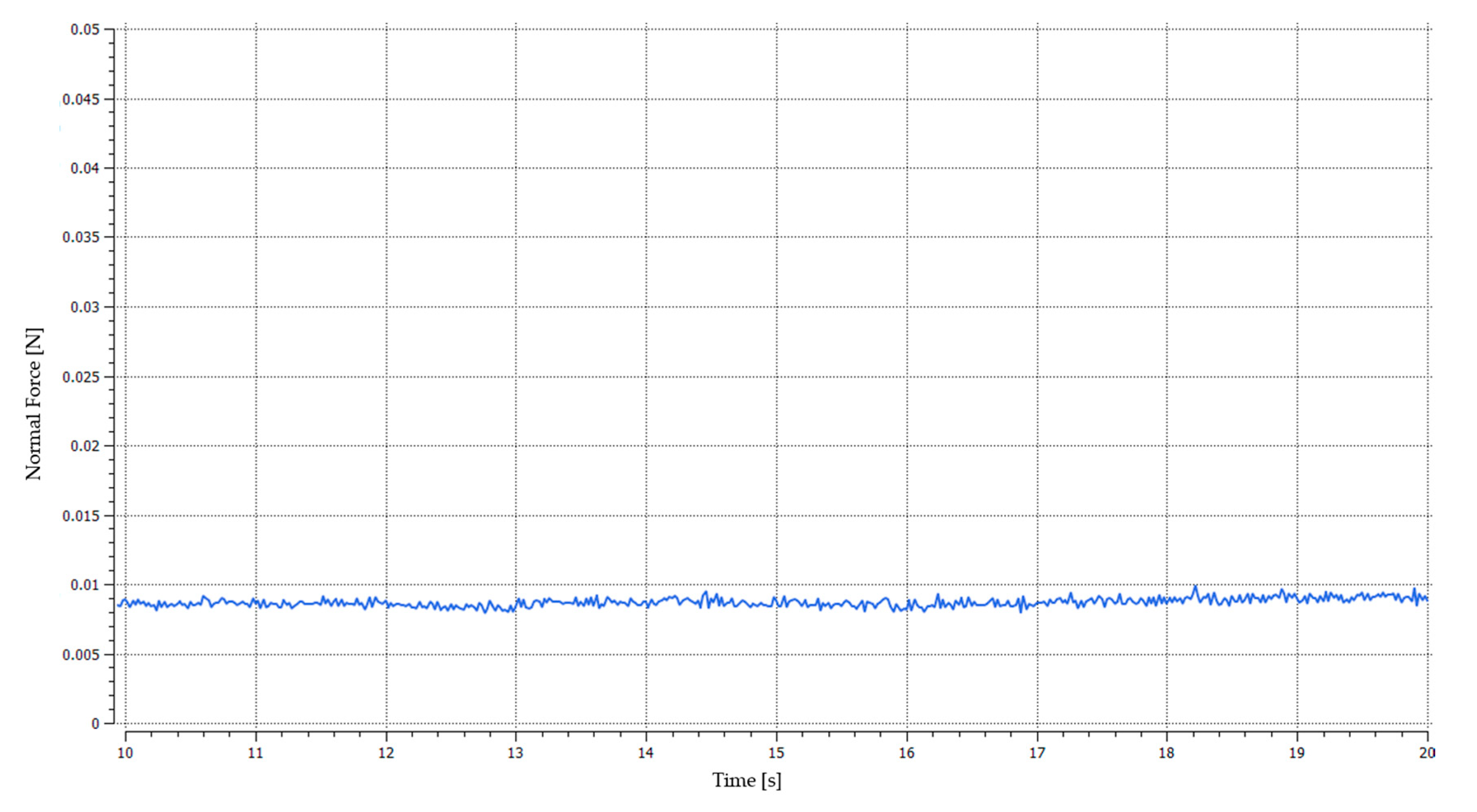


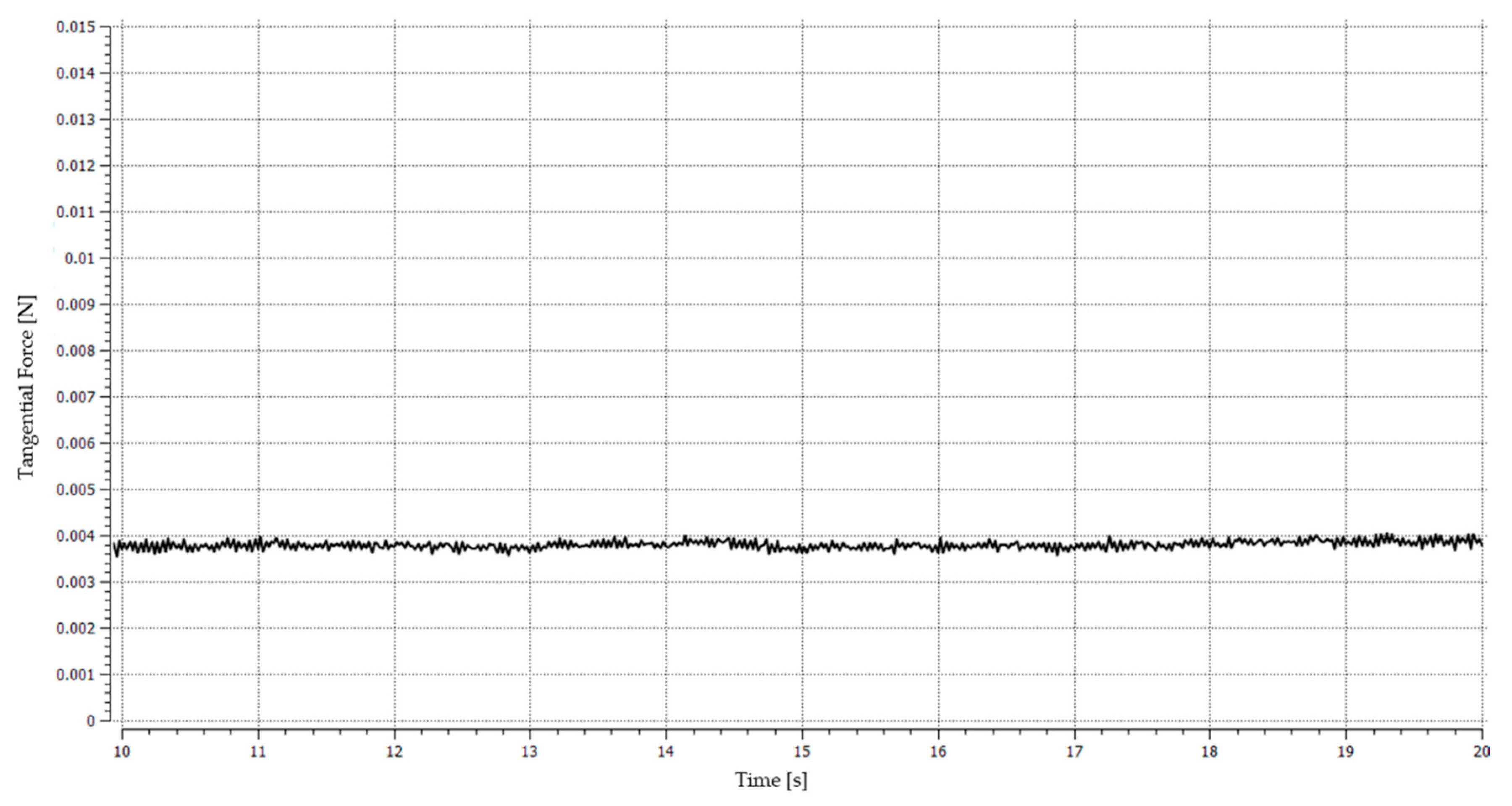
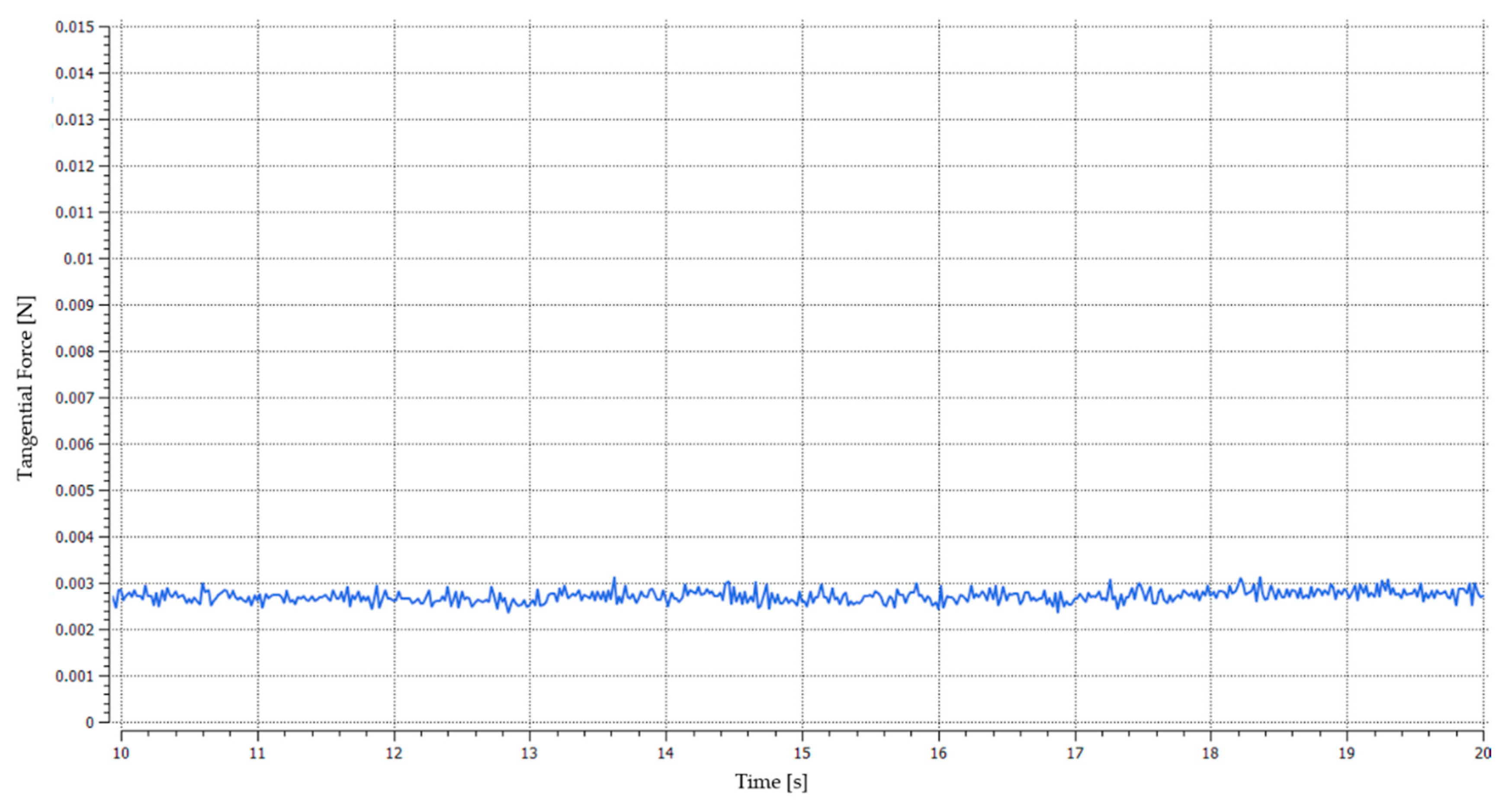
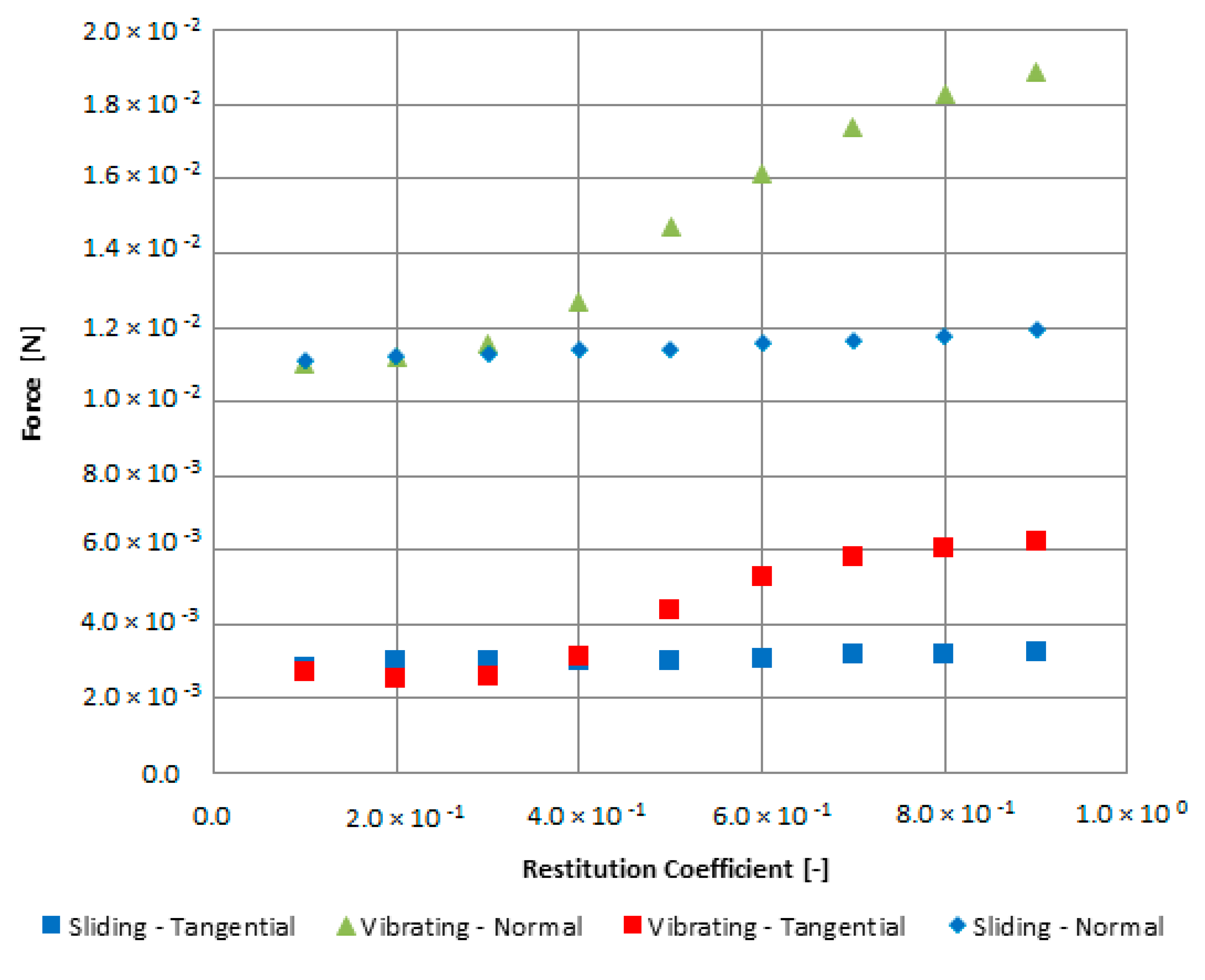
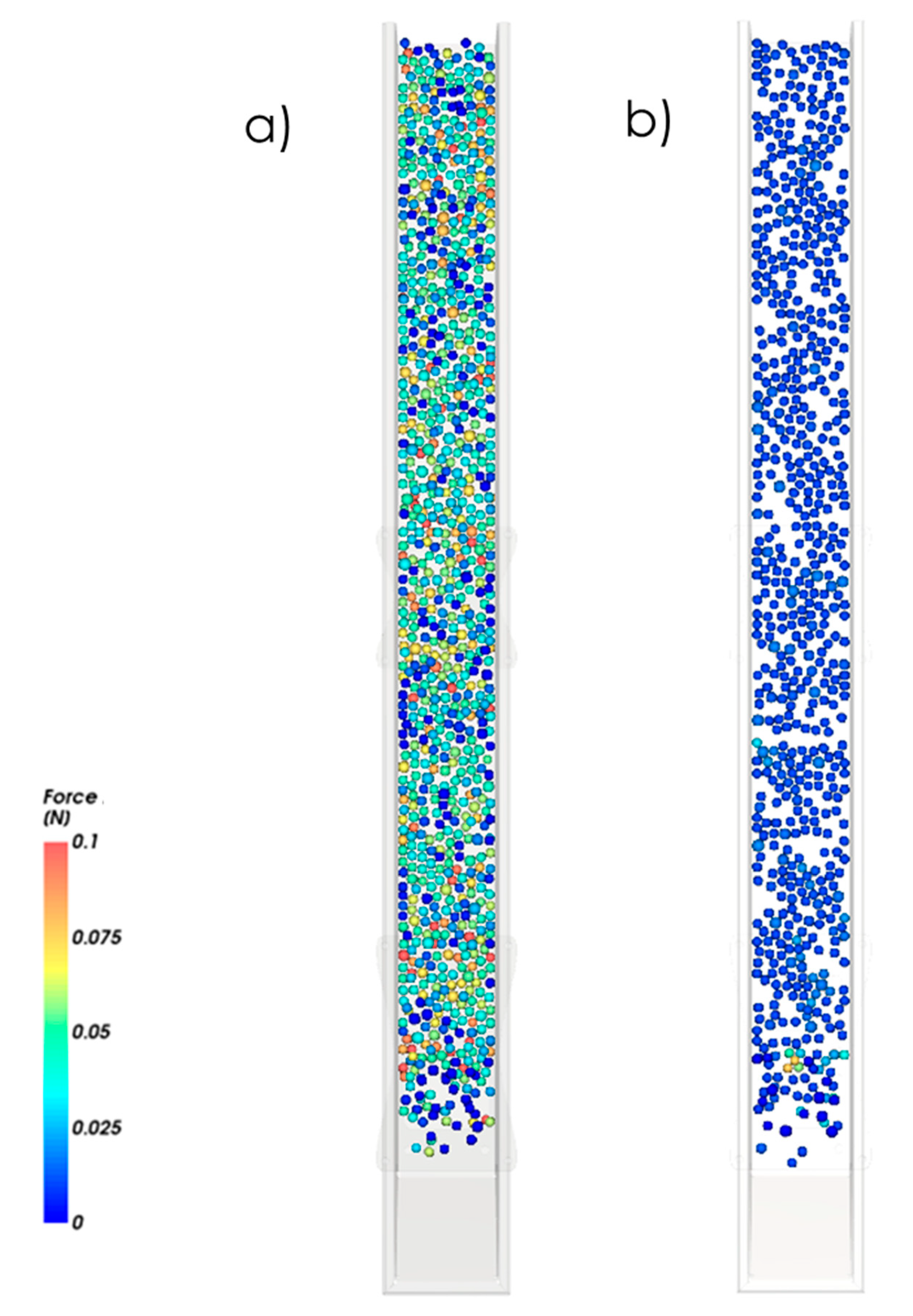
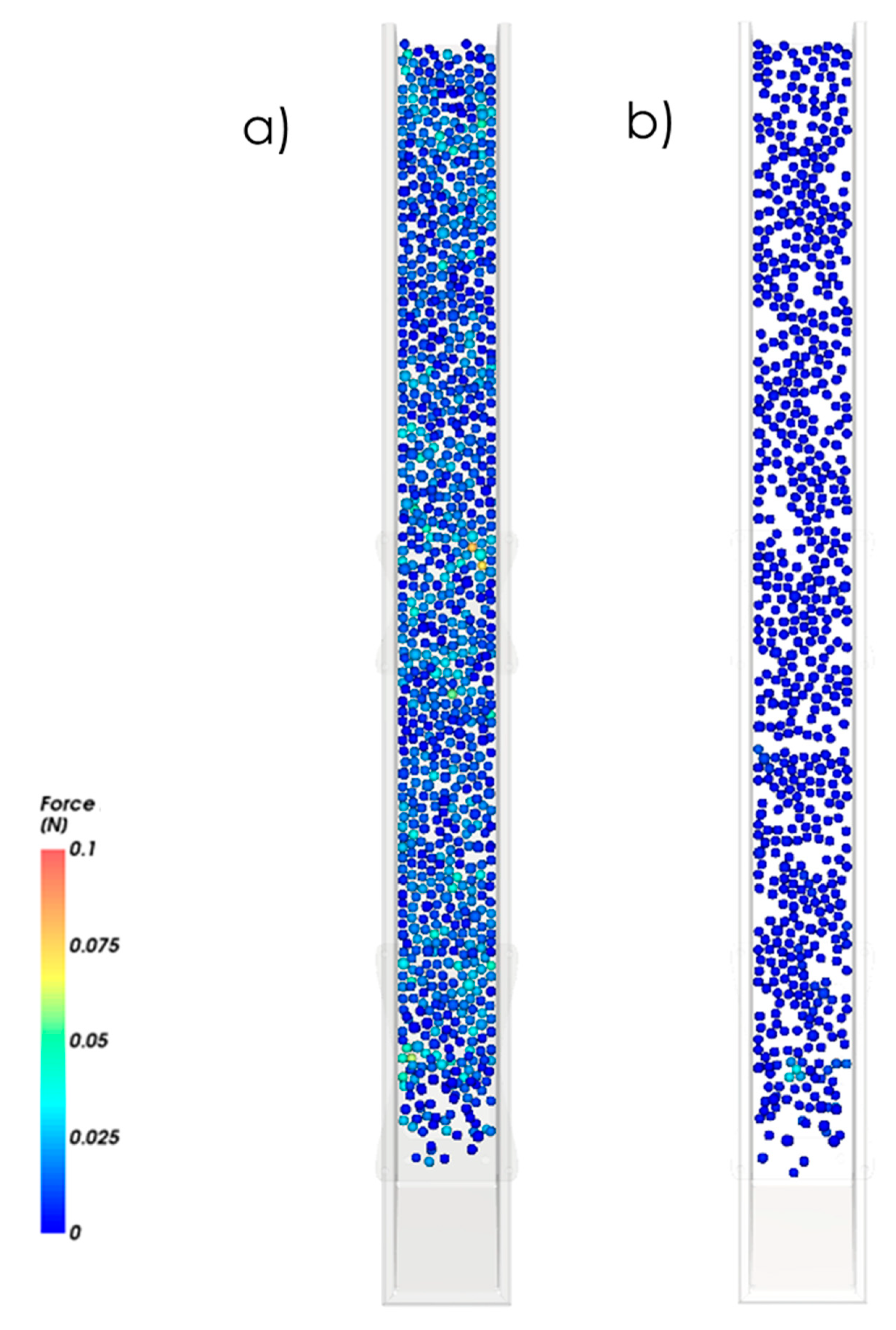
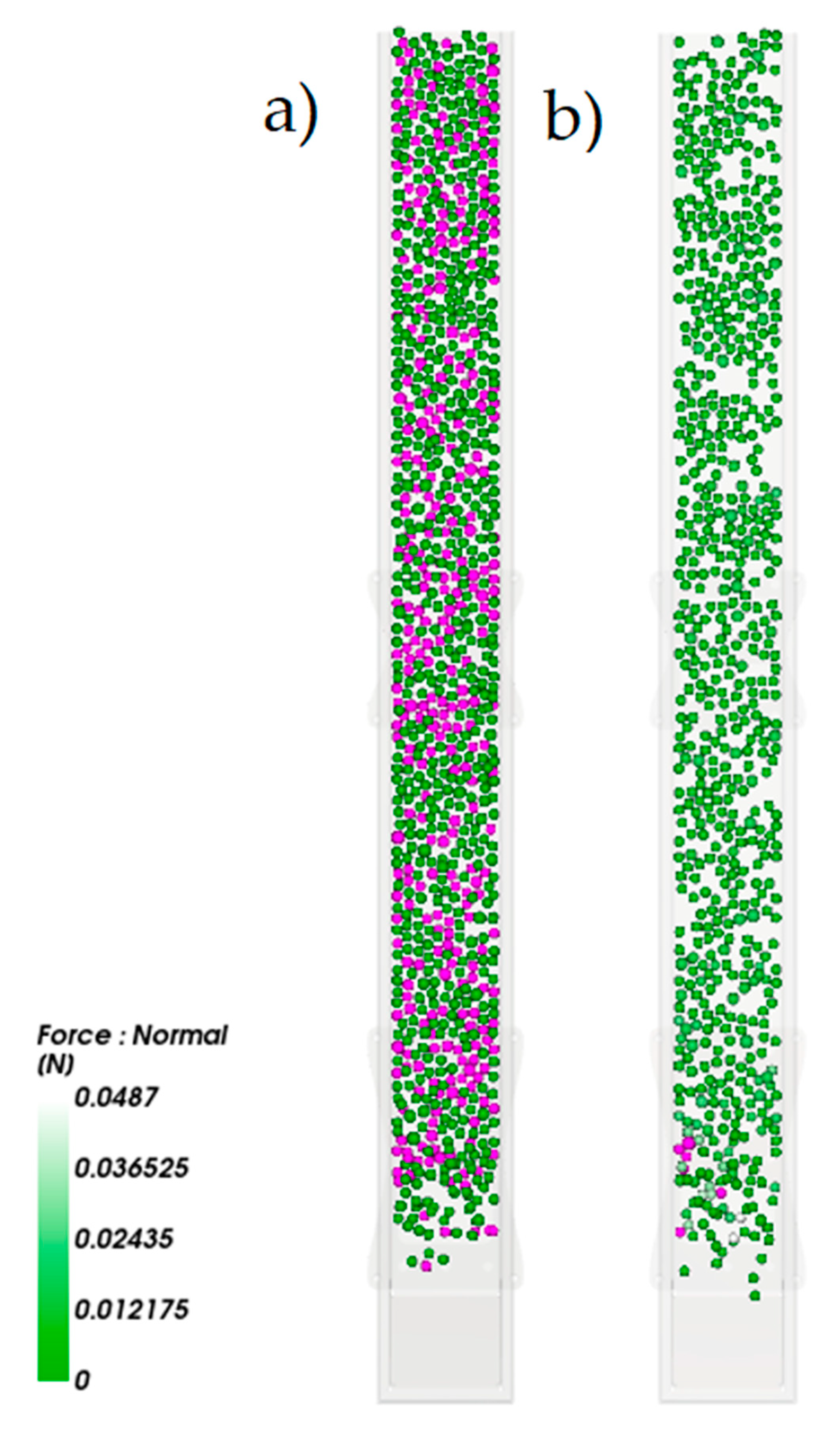
| The Variable | The Value |
|---|---|
| The coefficient of static friction of blueberry walls | 0.6 |
| The coefficient of dynamic friction | 0.6 |
| The coefficient of static friction of blueberry–blueberry | 0.7 |
| The coefficient of dynamic friction | 0.7 |
| Bulk density, kg/m3 | 640 |
Publisher’s Note: MDPI stays neutral with regard to jurisdictional claims in published maps and institutional affiliations. |
© 2020 by the authors. Licensee MDPI, Basel, Switzerland. This article is an open access article distributed under the terms and conditions of the Creative Commons Attribution (CC BY) license (http://creativecommons.org/licenses/by/4.0/).
Share and Cite
Kryszak, D.; Bartoszewicz, A.; Szufa, S.; Piersa, P.; Obraniak, A.; Olejnik, T.P. Modeling of Transport of Loose Products with the Use of the Non-Grid Method of Discrete Elements (DEM). Processes 2020, 8, 1489. https://doi.org/10.3390/pr8111489
Kryszak D, Bartoszewicz A, Szufa S, Piersa P, Obraniak A, Olejnik TP. Modeling of Transport of Loose Products with the Use of the Non-Grid Method of Discrete Elements (DEM). Processes. 2020; 8(11):1489. https://doi.org/10.3390/pr8111489
Chicago/Turabian StyleKryszak, Dariusz, Adrian Bartoszewicz, Szymon Szufa, Piotr Piersa, Andrzej Obraniak, and Tomasz P. Olejnik. 2020. "Modeling of Transport of Loose Products with the Use of the Non-Grid Method of Discrete Elements (DEM)" Processes 8, no. 11: 1489. https://doi.org/10.3390/pr8111489
APA StyleKryszak, D., Bartoszewicz, A., Szufa, S., Piersa, P., Obraniak, A., & Olejnik, T. P. (2020). Modeling of Transport of Loose Products with the Use of the Non-Grid Method of Discrete Elements (DEM). Processes, 8(11), 1489. https://doi.org/10.3390/pr8111489






